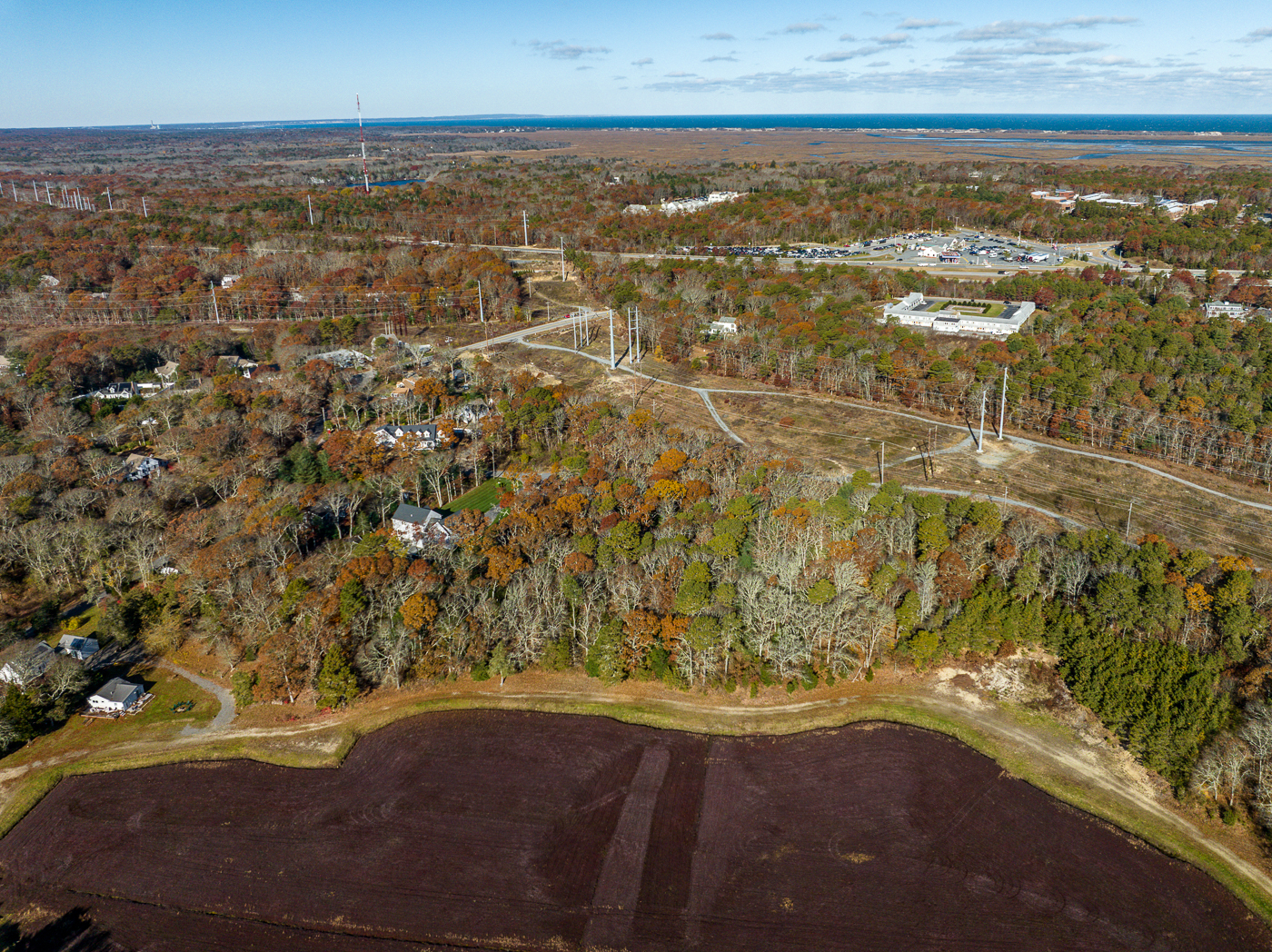water Contamination
protecting our drinking water
The source of water on the cape is fragile and must be protected.
The Cape Cod Aquifer provides 100% of the Cape’s drinking water, and for this reason has been designated a Sole Source Aquifer under the Safe Drinking Water Act by the Environmental Protection Agency. The highly permeable aquifer deposits make the Cape Cod Aquifer one of the most productive groundwater systems in New England, but this also mean water supplies are susceptible to contamination from development and land uses within their watersheds.
Cape cod
Freshwater lenses
In certain inland areas, groundwater has great distances to travel before it reaches the shore. Over time, precipitation in these areas has led to an accumulation of recharge, which appears as a mound of higher elevation groundwater. These mounds of groundwater are relatively thin and convex, and therefore are referred to as “lenses” of groundwater. Six separate lenses comprise the Cape Cod aquifer system, as shown here. Barnstable is within the Sagamore Lens.
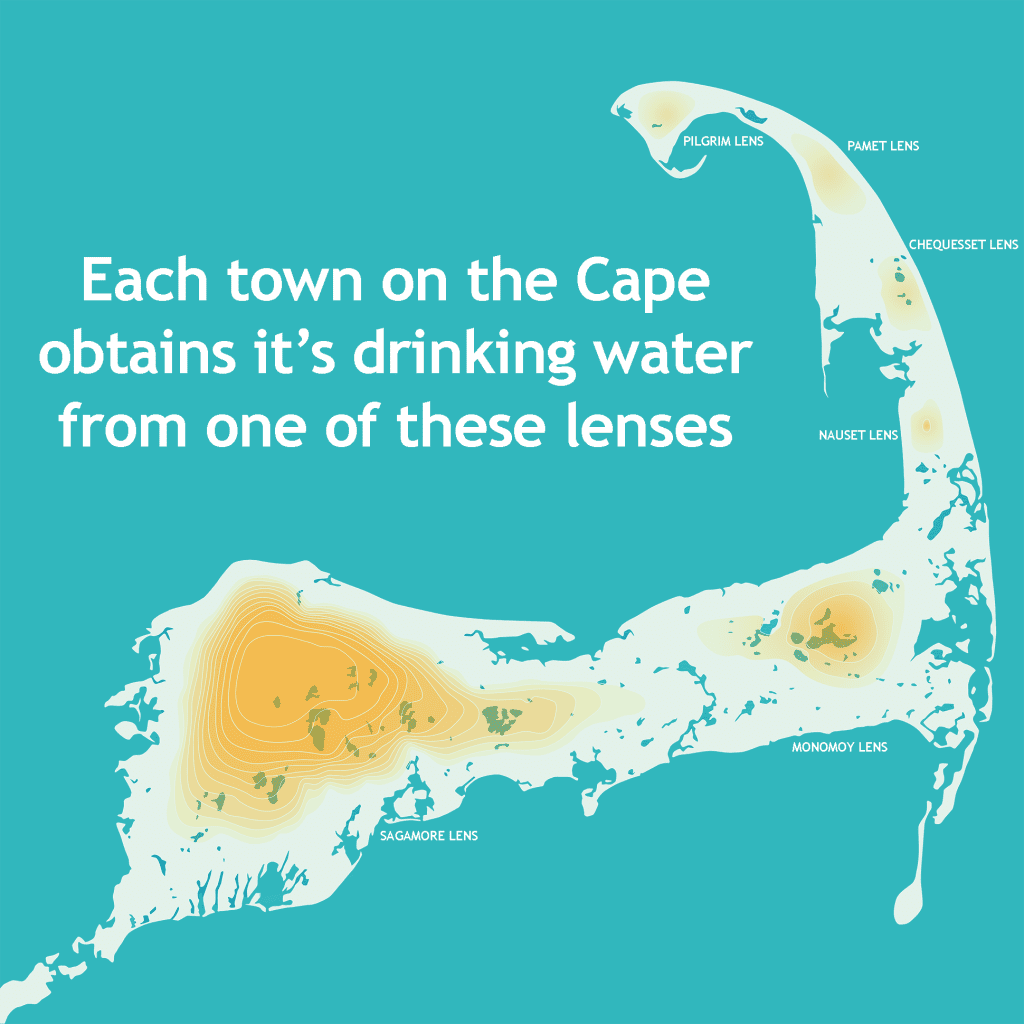
How cape cod’s aquifer works
The aquifer is deeper further inland and becomes shallower near
the coastal edges, giving it a concave shape that resembles a
lens. Because freshwater is less dense than saltwater, the fresh-
water lens floats above the surrounding saltwater.
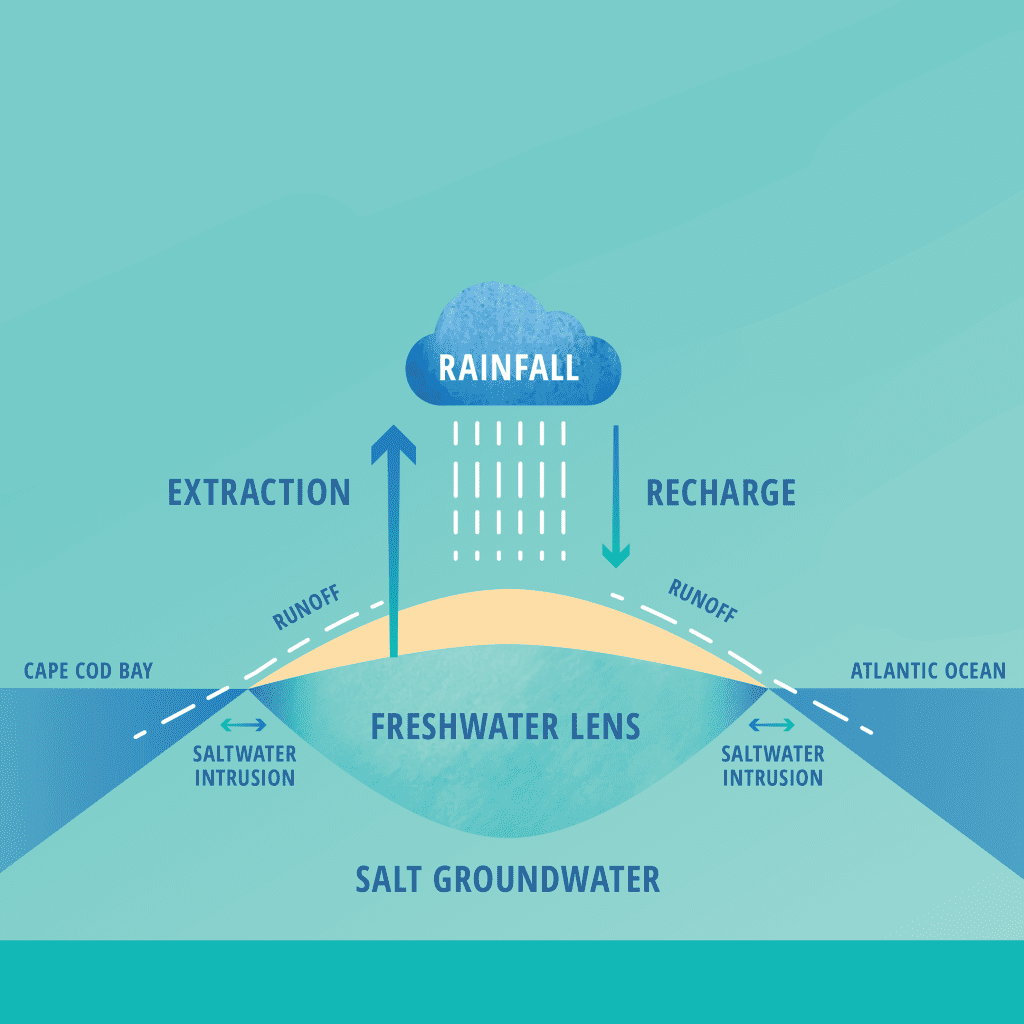
Threats to the waterways
The proposed projects are located above our sole source aquifer and in well-protection designated areas. The Sagamore lens supplies all of Cape Cod’s drinking water and in the event of a catastrophe, water quality or availability would be threatened.
Contamination has already been a major issue, with the town spending 27 million dollars to clean up PFAS contamination of municipal water supplies from firefighting foam once used at the Barnstable County Fire Training Academy.
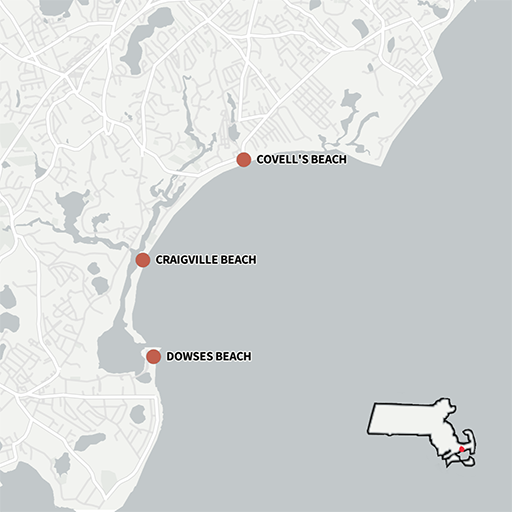
Proposed Offshore wind projects
Landing sites for high voltage cables
Following the installation of Vineyard Wind’s electric cables, carrying a total of 800 megwatts of electricity, under Covell’s Beach and Barnstable’s residential and commercial roads, the fight turns to the other proposed landing sites for these high-voltage cables, Craigville Beach and Dowses Beach.
These cables will be buried 10 feet below the ocean floor before being placed through encasements of cement that are under residential and commercial neighborhoods in the process of connecting to the regional grid at large, newly constructed power substations.
proposed substation
substation location
Here are some drone shots of the proposed substation site at 8 Shootflying Hill Road, Barnstable. It’s 6.7 acre of privately owned land.
Also shown are the nearby cranberry bog, and the Knights Inn motel, which will be demolished to make way for the substation.
125K gallons of dialectric fuel is to be stored in this location. In the event of a major spill, this fluid could have a disasterous effect on the quality of the nearby groundwater.
In addition to the fuel, 45,000 pounds of SF6 gas will be stored in this location. The EPA states that that SF6 is is one of the most harmful greenhouse gases known. See: https://www.epa.gov/eps-partnership/sulfur-hexafluoride-sf6-basics. “SF6 is the most potent greenhouse gas known. It is 23,500 times more effective at trapping infrared radiation than an equivalent amount of CO2 and stays in the atmosphere for 3,200 years.”
An additional substation is proposed to be built for the Commonwealth Wind project. This substation would be on 28 acres of currently forested land, located at the highest point on Cape Cod. Additionally, these proposed projects will require the expansion of Eversource’s existing substation on Oak Street in West Barnstable. The proposed expansion project would almost double the amount of toxic dielectric fluids store on site from 39,000 gallons to 70,000 gallons. This substation is also located atop the Cape’s sole-source aquifer and Barnstable’s designated wellhead protection areas.
Charles mcLaughlin, Senior Attorney, town of barnstable
“The chemical components appear to present a real threat to us,” McLaughlin explained. “We are concerned that a spill could leach into the groundwater 50 feet below the surface.”
In fact, McLaughlin said, one gallon of dielectric fluid, which is used to cool hot electric components, released into 5 million parts water would pollute 5 million gallons of water in seven days’ time, and the results would be catastrophic.
C.McLaughlin. Quote from: https://eu.barnstablepatriot.com/story/news/politics/government/2018/05/23/vineyard-wind-plan-gets-mixed/12151357007/
(Date: 05-23-2018)
water department official concerns
After a public hearing in which the West Barnstable substation expansion was discussed, the board of water commissioners expressed concerns and asked for further review of the impact of these projects on Barnstable water sources.
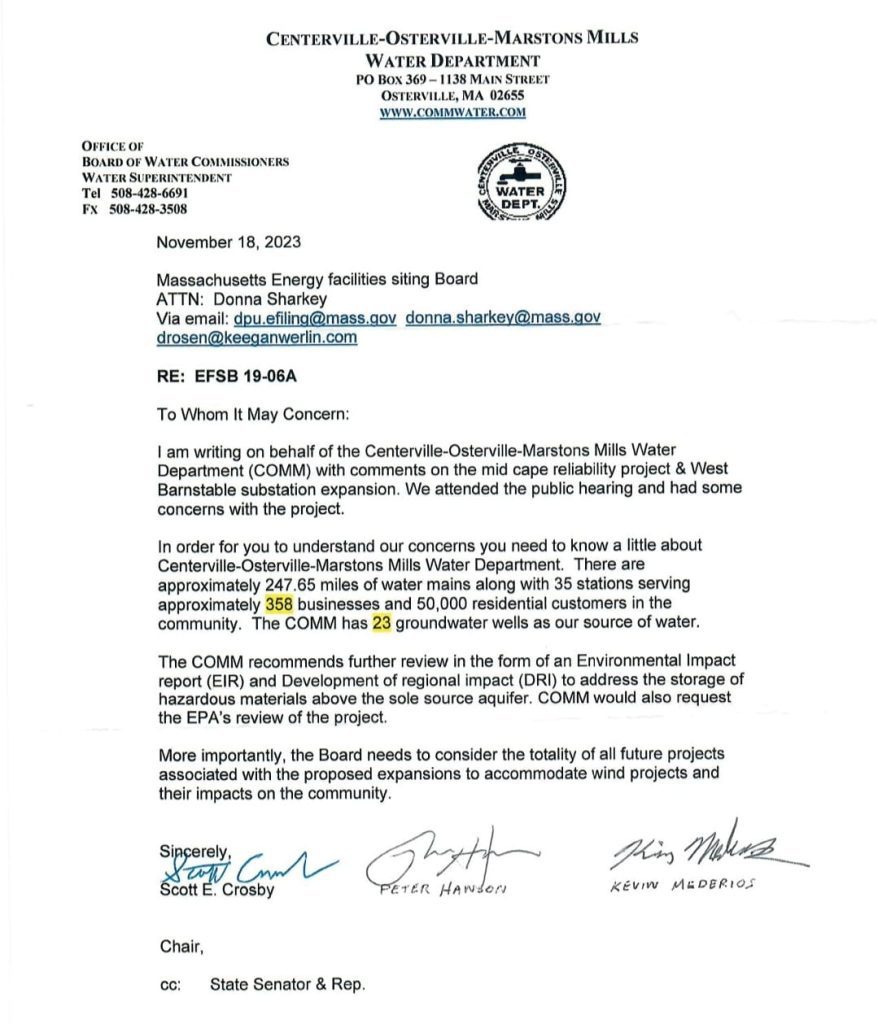
Vineyard wind & Barnstable water supply
Barnstable’s officials are concerned about Vineyard Wind contaminating our water supply. Shared by our friends at Preserve Covells Beach (https://preservecovellsbeach.com)
Read Barnstable’s Expert Witness Testimony Below:
Ann Marie Petricca, Certified Professional Geologist
” Barnstable’s sole-source aquifer is, by definition, its only source of potable water. A D.P.U. waiver of zoning in this respect is inconsistent with sound public policy and potentially allowing a lesser standard of protection by granting the requested zoning waiver will unnecessarily put Barnstable’s water supply at a higher degree of risk. Doing so would be inconsistent with the mandate and the Company’s plans are “consistent with current health, environmental protection, and resource use and development policies as adopted by the Commonwealth.” “
A.Petricca. Quote from: Commonwealth Of Massachusetts Energy Facilities Siting Board EFSB 17-05/D.P.U. 18-18; 18-19
(Date: August 27, 2018)
Elizabeth S. Jenkins, Director of Planning and Development
“I am also well aware of the challenges it faces and the risks that the Vineyard Wind project in Independence Park pose to the water system”. “I am firmly of the opinion that waiving the town’s zoning ordinances that protect groundwater and wellhead is terrible public policy.”
E.Jenkins. Quote from: Commonwealth Of Massachusetts Energy Facilities Siting Board EFSB 17-05/D.P.U. 18-18; 18-19
(Date: September 11, 2018)
Hans Keijser, Supervisor, Hyannis Water Supply, Director of Planning and Development
“The proposed substation sits atop the sole-source groundwater supply which is directly upstream from the Mary Dunn wellfield. If there is a release of dielectric fluids to the groundwater at the substation, it will flow downstream and be drawn into the Mary Dunn wellfield in as little as 7 days from entering groundwater. Such a release could also be drawn into the Yarmouth water supply shortly after reaching the Mary Dunn wells”
H.Keijser. Quote from: Commonwealth Of Massachusetts Energy Facilities Siting Board EFSB 17-05/D.P.U. 18-18; 18-19
(Date: September 5, 2018)
Daniel Santos, Director, Department of Public Works
“As the Director of the Department of Public Works of the Town of Barnstable, I am very familiar with the Hyannis Water System and the challenges it faces and the risks that the Vineyard Wind project in Independence Park pose to the water system. I have been asked to examine this project and provide evidence to the Siting Board.” Q. Have you reviewed and do you adopt the testimony of Hans Keijser? A. “I have done so and adopt it as submitted”
D.Santos. Quote from: Commonwealth Of Massachusetts Energy Facilities Siting Board EFSB 17-05/D.P.U. 18-18; 18-19
(Date: September 11, 2018)
Peter J. Burke, Jr., Chief, Hyannis Fire Department
“High voltage electricity and salt air and water do not mix. Additionally, the WTG (Wind Turbine Generator) itself, located offshore provides an inherently complex and dangerous environment. It is not a matter of if, but only when, that mix will produce personal injury, explosion, and/or fire.”
P.J.Burke.Jnr. Quote from: Commonwealth Of Massachusetts Energy Facilities Siting Board EFSB 17-05/D.P.U. 18-18; 18-19
(Date: September 5, 2018)







